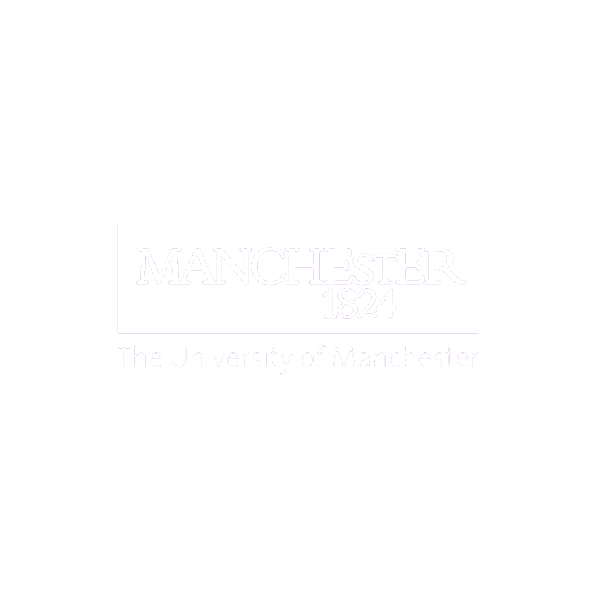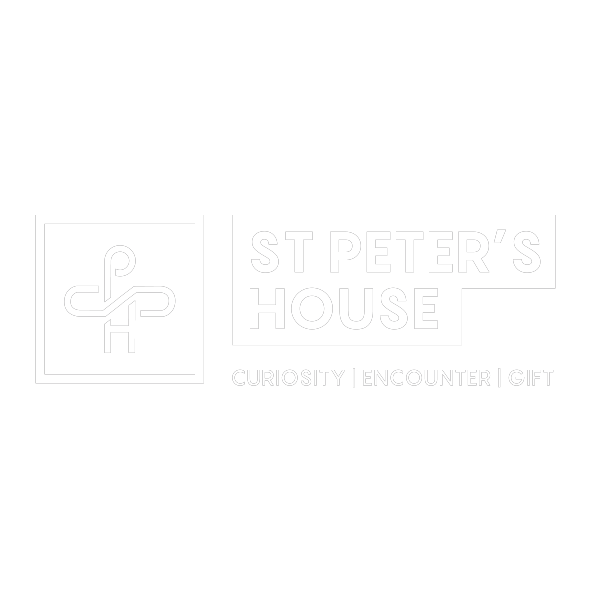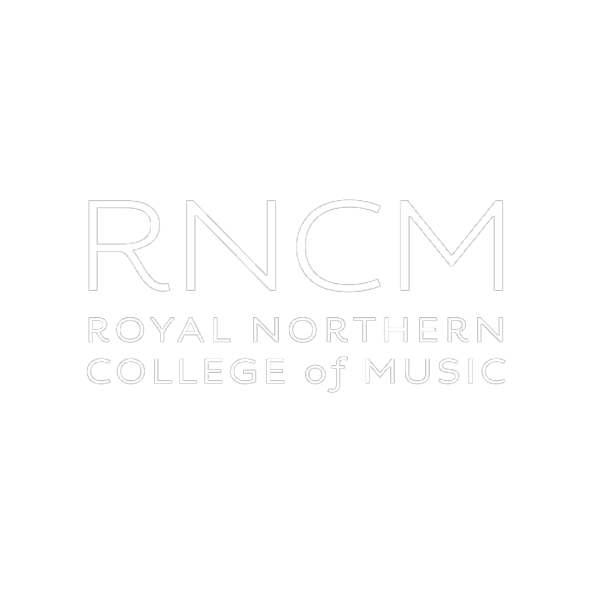My own disabled identity has been through denial to shame to acceptance… so how does Pride fit in?

some standing, one seated in a wheelchair and one using a mobility aid. Image credit: sociotab.com
I can’t say I’ve been counting down to July and Disability Pride Month, because – in all honesty – I’d never heard of it until it rolled around. It was only through some dedicated research (i.e. an Instagram scroll…) that it entered my consciousness, and it turns out I’m pretty much a standard example in my “Disability…what?” response.
Needing to know what I’m missing out on and what it’s all about, I turned to the voices and words of the community. So…
What is Disability Pride Month, and what does it mean to us?
Whilst Disability Pride Month has been going on for 30+ years, most of us – including those within the disabled community – have never heard of it.
Beginning in Boston in July 1990 with an event to celebrate the passing of the American Disability Act (which prohibited discrimination against disabled people), Disability Pride Month was born and has spread around the globe.
It’s now celebrated and marked in various ways in cities and online – although the only parades and events in the UK (so far) happen in Brighton (of course!)
So, what’s the point of it all?
A definition of the word ‘Pride’ is ‘A reasonable or justifiable self-respect’. I believe that each person is worthy of this, and yet – through disablism and systematic ableism, disabled people’s self esteem and sense of self-respect are so often slowly broken down until it can feel impossible to keep any sense of pride in personal identity.
Particularly in the identity of a ‘disabled person’.
Disabled Pride Month is a time to name and challenge stigmas, to create awareness of the discrimination and ableism that deaf and disabled people face, and – more positively – to promote disability as an identity and culture and share a sense of the positive pride felt by many disabled people.
Non-disabled people are asked to be allies and friends – celebrating, protesting, and resisting systematic injustices alongside disabled people.
Sounds good. No problems here…
Except, I can immediately see how this is challenging, upsetting, guilt-inducing and more for some members of the disabled community (and other disabled people, who may not feel part of a community – and in fact feel isolated, lonely and even like they don’t deserve to call themselves ‘disabled’ at all in absence of a solid diagnosis.)
This is the problem… every person is unique and complex, and each disabled person is just the same.
They may have been born with their impairment or health condition, or developed it through accident or illness. They may embrace and feel pride and positivity in their disabled identity, or they may mask it and be exhausted from attempting to ‘pass’ day-to-day in work, school or in front of loved ones. Or they may fluctuate depending on symptoms and mood.
Some may feel exhausted by the idea of Disability Pride (“another event where we need to self-advocate to show the world we’re here!”), some may feel a sense of guilt or pressure if they resent their impairments. Some just see it as tokenistic.
The reality is that it’s highly complex. It’s not just a case of hanging out the Disability Pride Month Flag and ticking it off the ‘diversity calendar’. It requires some proper listening, learning, and a deep respect for what disabled people have to teach us about their experience of being human.
Listening to myself
I needed to do some deep listening over the past few years as I came to terms with my own disabled identity. It’s an honest statement when I say ‘came to terms’ as I’m aware that doesn’t sounds positive, and certainly not very ‘Pride’
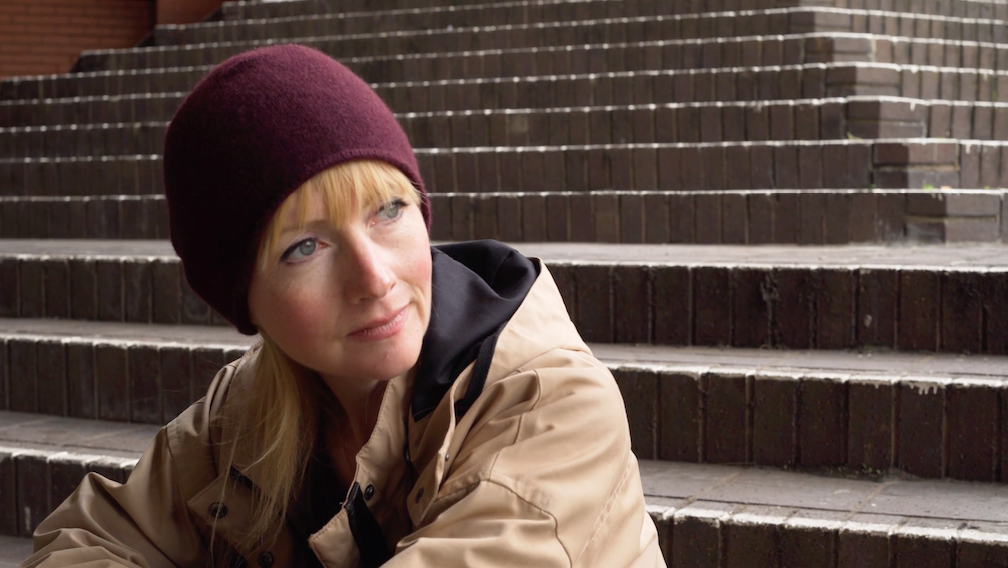
For me, living for a number of years now with neurological illness causing symptoms including loss of balance, unsteadiness, visual disturbance, facial pain, headaches and weakness on one side of my body (added to the inflammatory arthritis I already had, with associated immunosuppression medication and all that follow-on fun), I can’t say I’ve been going around with a great deal of positivity and pride about these impairments and conditions. In fact, for a long time I actively resisted seeing them as part of my identity.
Un-helped by often well-meaning comments (“I just want you to get back to normal”, “when will you be able to drive/be yourself/start coming out more again…?” or “aren’t you better yet”), I was ashamed and guilty of who I was and hoped – unrealistically – that I would return to ‘normal’.
Lonely and largely housebound as my neurological medications rewired my brain and I tried to rebuild my balance and tolerance to noise and light, slowly returning to the world whilst desperately ‘masking’ all my symptoms until – on repeat – I burnt out and had to begin again.
Around this time, a little seed long since planted in my life began to shoot and root again as I returned o meditation and mindfulness. I found simple stillness each day inside myself through discipline and practice, so needed in my off-balance and scary world! It gave me space and silence to hear myself and extend compassion – to others, but more importantly to myself.
For who I now was, but who I still am. The unchanged fire and heart in me that is so much wiser, stronger and kinder for knowing and growing as a disabled woman.This is not every disabled person’s experience, but is mine. It is not even mine everyday! Some days are bad days – and I still don’t show my struggles to anyone other than my closest family, staying home and cancelling everything when symptoms and impairments flare. However, it is my journey towards Pride (very much a work in progress) so I share my story with hope.
Flying the Flag
Despite being largely unheard of, if you want to fly the flag this Disability Pride Month you can do just that. In fact, the story of the flag is a great place to start if you’re not sure where to start in story-telling and sharing positive messages about the month.

stripes right-left of muted red, yellow, white, blue and green
Designed by Ann Magill, a disabled woman, the flag originally included brightly contrasting colours and a lightening flash to represent the obstacles in society that disable people with impairments and long-term conditions. However, after people within the community pointed out how the symbol and colours were inaccessible and potentially triggering for those with neurological conditions it was redesigned by Ann in collaboration with the online disabled community.
Each of the colours symbolise a different part of the disabled community:
- Red – Physical disabilities
- Yellow – Cognitive and intellectual disabilities
- White – Invisible and undiagnosed disabilities
- Blue – Mental Illness
- Green – Sensory Perception disabilities
The Black field represents those who have died not only due to their disabilities and illness, but also because of suicide, medical negligence and eugenics. It feels especially important to remember this ‘black field’ in these dark times. Despite insistence from Westminster that the pandemic is yesterday’s news, covid-19 is a daily lived reality for many disabled people. After many pandemic months/years – where the filtered-down public narrative has been that the ‘vulnerable’ are expendable, and so long as we stay indoors everything can sooner get ‘back to normal’ – structural discrimination feels intrinsically embedded in UK policy.
Tragically the effect has been that 58% of people who’ve died from covid-19 in the UK so far have been disabled. With many more lives changed beyond recognition through Long Covid, and lack of access to the usual treatments, clinics and healthcare that kept us well and connected.
Things to learn this Disability Pride Month (if you’re non-disabled), and then do all year.
- Remember one thing: Disabled is not a Bad Word.
My opinion, this is a biggie. Just like a lot of people seem to feel creepy about talking about death (in case it makes them die?), there’s a lot of people who struggle to say the D-word (in case it…what?) Disabled is not a dirty word. You might become a disabled person at some point – anyone could – but it won’t be saying disabled that made that happen.
Most disabled people are fine being called just that. If in doubt, ask. But never think it’s better to pretend you haven’t noticed and leave the person having to self-advocate or fight to make their voice heard all the time. If they don’t want to talk about it, they can tell you. Just ask them nicely.
- Ask People about their Accessibility Requirements
Ideally every building and space would be fully and equally accessible to each person. However, this is the real world and we’re a long way from that. In the meantime, don’t try and save people (or yourself) embarrassment by not asking what accessibility requirements they have.
Then do what you can to make it as easy as possible for everyone to have equal access. If you are a budget-holder for a building (or country!), prioritise this. If you are a HR manager, don’t push resourcing your team with what they need for equal access at work to the end of your to-do list. If you are a friend, be mindful of locations, accessibility, fatigue and invisible barriers that you may not be aware of.
- Educate Yourself and Join the Conversation
22% of the UK population are disabled – I’m no mathematician, but that’s nearly a quarter. We’re talking about a lot of people.
Did you know that in the UK disabled people don’t have marriage equality? That’s because if they marry -or even co-habit – they stand to lose vital parts of the disability benefits that support (to some extent) their day-to-day life , therefore reducing any financial independence they may have. This in turn increases the incidences of intimate partner abuse of disabled people.
Do you know what the Personal Independence Payment is for an adult? If not – look it up, and decide if you could live on that. Perhaps consider too that there is an employment gap of nearly 30% between disabled and non-disabled people, and question why it is that so many within our society are facing challenges to employment.
Educating yourself – online, books, films, conversations, training and events – are crucial steps towards understanding and being part of a bigger movement towards change.
- Actively Challenge Ableism in Action
Every time you enter a room and you see a wall of white, cis, hetronormative dudes backslapping and planning the next step in the patriarchal power-dom, you may look around and think “where are my queer, rainbow-hued BIPOC siblings?” Wonderfully, these movements to overturn oppression have often run hand-in-hand with disability-empowerment, but now it’s time for you – friends and allies – to begin to think the same.
When you see steps, think “what kind of access is this?!”
When you see blue LED lights and banks of glaring screens, think “what kind of sensory, neurological access is this space offering?”
When you see heavy doors with small handles, think “what kind of body planned, design and installed this space?!”
Notice ableism in its various forms – in physical space, in HR requirements, in public and fiscal policy, in public transport, in family law, in education and everywhere else. Then begin to speak about it, so that disabled people don’t need to use their energy and resources endlessly advocating for themselves on repeat.
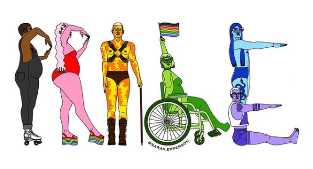
one seated in a wheelchair and one sitting on the floor.
Their bodies spell the word PRIDE.
Image credit: Sarah Epperson, Instagram.
So, there’s a 10-minute crash course in Disability Pride Month. It’s not straightforward, and every disabled person will have their own feelings and attitude towards the idea of ‘pride’. It’s their body, it’s their story, and their voice is the one to listen to.
At St Peter’s House this year we’re going to share some thoughts and content this month, and we’re going to be hanging the Disability Pride Flag to start a conversation and to raise awareness that there is much to be celebrated in the experiences and community of disabled people.
It will also serve as a reminder of the work ahead, as we look towards a future that is just and includes everyone – and where each person can flourish and celebrate their human Wholeness, just as they are.
Hannah Skinner

